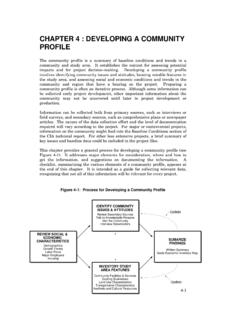Transcription of Groupwork Practice for Social Workers - SAGE …
1 Groupwork Practice for Social Workers 1 11/11/2014 7:36:56 PM. 1. INTRODUCING Groupwork . chapter summary In this chapter you will learn about the overall purpose, aims, scope and features of this book how the book is structured and the brief contents of each chapter how the book is aligned with a range of national standards and requirements related to professional Social work education and Practice the key themes that underpin the whole book the range of terms, words and phrases used to describe Groupwork INTRODUCTION. Groups are the basic expressions of human relationships; in them lies the greatest power of man. To try to work with them in a disciplined way is like trying to har- ness the power of the elements and includes the same kind of scientific thinking, as well as serious consideration of ethics.
2 Like atomic power, groups can be harmful and helpful. To work with such power is a humbling and difficult task. (Konopka, 1963: vii viii). Social work practitioners work with groups of people in many different ways and in many different contexts. Whilst some of the wording in the above quotation may reflect the date it was written, some fifty years ago, it powerfully reflects the com- plexity of challenges and opportunities that may arise in contemporary Groupwork Practice . This book sets out to help you, the reader, understand and develop the knowledge, skills and values that are required to practise effectively in this complex 01_Crawford_Price_BAB1407B0153_Ch 01 Part 3 11-Nov-14 4:08:59 PM. 4 Groupwork Practice FOR Social Workers . context. In exploring Groupwork for Social Workers who work with adults and chil- dren across a whole range of needs, this book takes a generic approach.
3 This introductory chapter will provide you with an overview of the whole book, laying out its purpose, aims and scope through an outline of the structure, key themes and learning features. This chapter will also identify how the contents of this book are related to key national standards and requirements for Social work Practice and education. As an introduction to your learning across the book, this chapter can be likened to a course induction process. Given the significance of language, terminol- ogy and discourse to how we understand and interpret the world around us, in order to inform your studies through the book, this chapter also includes discussion about the different definitions and understanding of the terms group' and Groupwork '. Despite the acknowledged complexity and powerful opportunities offered through effective Groupwork , there has been recognition over a number of years that this aspect of Practice is at times perceived as marginal, out-of-date (Doel and Sawden, 1999) and of less value or importance than other aspects of Practice , particularly those underpinned by procedural and managerial drivers (Preston-Shoot, 2007).
4 It is our intention through this text to further your understanding of the value of work- ing with groups and thereby to raise the profile of Groupwork Practice as one of many aspects of effective professional Social work intervention. By engaging with the materials in this book you will be able to develop your knowledge, skills and values for groupworking in the complex interprofessional care and support environment. Throughout the chapters there is an emphasis on the experience of group members and how they can fully and meaningfully participate in all aspects of the group pro- cess. This chapter summarises how the two parts of this book address theoretical, practical and methodological concerns, alongside thematic foci on empowerment, user participation and professional development.
5 BOOK STRUCTURE. This book is set out in two parts; the first part, Chapters 1, 2 and 3, set the context, background and theoretical approaches that underpin an understanding of group- work Practice in Social work. The second part of the book, Chapters 4, 5, 6, 7 and 8, builds on this knowledge, exploring Practice skills and directly discussing group- work Practice . The chapters that make up this second, Practice -orientated part of the book are structured to address the life course', or processes, of working with a group. The final chapter will summarise the book in a way that helps you to focus on your development as a Social work practitioner. Thus, by incorporating theory and Practice , with interactive content throughout, the book provides a Practice guide to support you in developing your skills, knowledge and approach to working with groups.
6 Each of the chapters is briefly summarised below. As well as address- ing key national standards for Social work, including the Professional Capabilities Framework, as you read and study this book, you will become aware of recurring key themes that are threaded throughout the text of each chapter . These themes are: 01_Crawford_Price_BAB1407B0153_Ch 01 Part 4 11-Nov-14 4:08:59 PM. INTRODUCING Groupwork 5. Values and ethics, anti-oppressive Practice , empowerment use of power;. The development of Practice skills and evidence-based Practice ;. Multi-agency and interprofessional working with others in groups;. The service-user experience and opportunity for participation in all processes of group- work development;. Professional development, evaluation of Practice , reflective and reflexive Practice .
7 chapter 2. This chapter sets the background and current context of Groupwork in Social work Practice . It includes some brief historical perspectives and contemporary examples of groupworking, including models of Groupwork . Thus the chapter will discuss the professional context of Groupwork , also exploring where the concept of Groupwork Practice interrelates with the work of other professionals, including community work. The chapter gives a broad overview of the tasks and respon- sibilities of the groupworker and consideration of Groupwork as a Social work intervention; this is then further developed in Chapters 4 7. The chapter will also introduce you to some of the different types of groups that you may work with in Social work Practice . chapter 3. As the final chapter in Part I of the book, chapter 3 provides an overview of the theoretical context of Groupwork Practice as it explores some examples of theories that might be used to aid understanding and Practice with groups.
8 Essentially a chapter in two parts, the first part of chapter 3 examines theories that explain group development; behaviours in groups and group processes; descriptive theories. The second part of the chapter moves on to explore theories that can inform Practice interventions through Groupwork ; prescriptive theories. The separation of descrip- tive and prescriptive theories in this way is a purely artificial one that aids structure and understanding through the text, as the two parts have significant overlap in that descriptive theories commonly inform prescriptive theory and thereby both are influential on Groupwork Practice . chapter 4. chapter 4 is the first chapter in the second part of the book, where each chapter will draw on earlier learning from Part I, but will focus on Practice skills, knowledge, eth- ics and values.
9 The chapters in this section follow the life course' of working with a group, with this first chapter setting the foundation by exploring Practice in prepar- ing for Groupwork . Central to this chapter are planning processes, in particular the chapter considers how service users may be supported to participate in planning Groupwork and the importance of planning, at this early stage, for evaluation of the whole process. As part of the planning work, the chapter encourages you to 01_Crawford_Price_BAB1407B0153_Ch 01 Part 5 11-Nov-14 4:08:59 PM. 6 Groupwork Practice FOR Social Workers . consider a range of practical issues, such as the setting and resources needed, as well as preparing for how to address complex issues related to inter-group and intra- group relations. The chapter will also consider how contemporary developments in Social networking and the use of information technology have influenced or can support Groupwork Practice .
10 chapter 5. Moving on from the groundwork set out in the previous chapter , chapter 5 explores the specific Practice skills, knowledge, values and ethics needed when initiating Groupwork . In particular, in this chapter you will learn about the important first session and the roles and responsibilities of practitioners in Groupwork . Through your studies in this chapter you will develop your understanding of intergroup rela- tionships, including consideration of issues of authority, control and power between group participants and groupworkers, and how you might manage these. The chap- ter also addresses the practicalities of process and content, in particular setting aims and objectives, achieving group consensus and establishing roles. Within this, you will also reflect on the role of Information Technology as an aid in the Groupwork process and how the skills and tools you need as a groupworker may differ when setting up and facilitating virtual groups.














